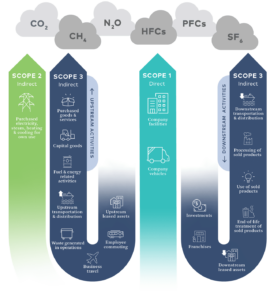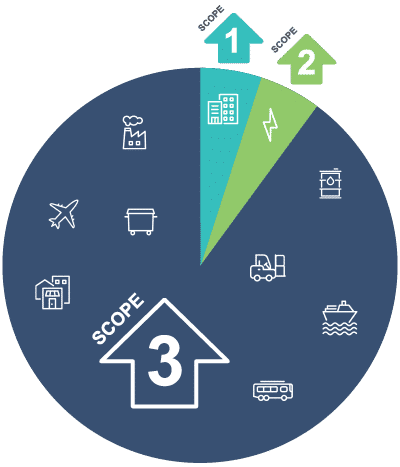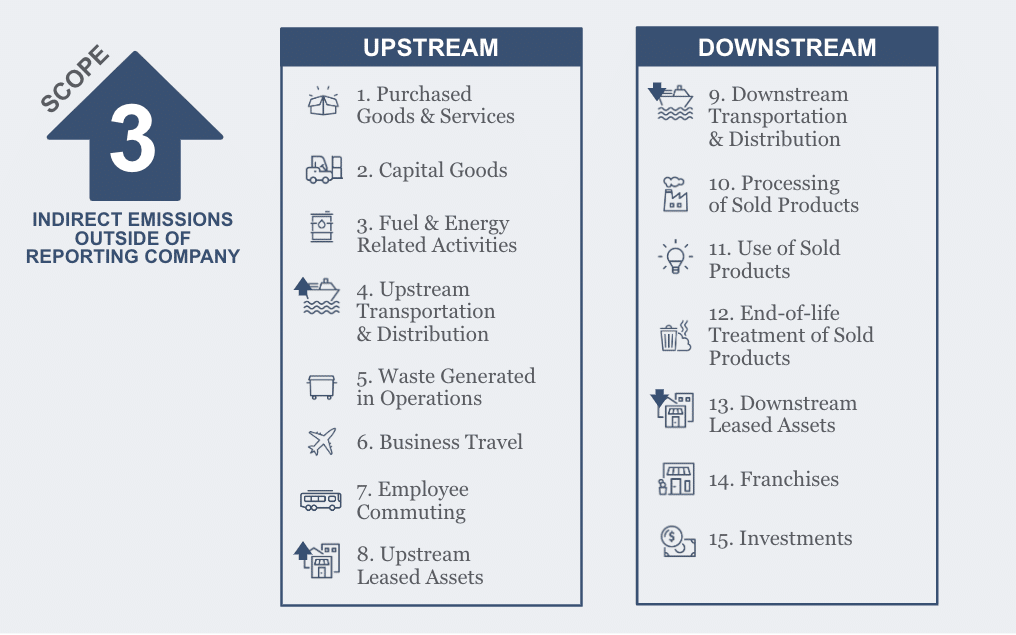Address scope 3 with renewable energy
Download our position paper to examine renewable energy as a scope 3 decarbonization solution.

When it comes to measuring and managing your greenhouse gas (GHG) emissions, your direct emissions aren’t the only ones that matter. In fact, indirect emissions, particularly scope 3 emissions, can comprise the bulk of your overall corporate emissions.
Plus, scope 3 emissions are typically the hardest to track and reduce, because companies can only influence—not control—these sources, such as supply chain emissions. Here, we’ll cover in more detail what scope 3 emissions are, how they compare to scope 1 and scope 2 emissions, and what you can do to mitigate scope 3 emissions.
WHAT ARE SCOPE 3 EMISSIONS?
Scope 3 emissions are commonly referred to as value chain emissions, as they stem from sources owned or controlled by other entities within a company’s value chain.
“In this standard, ‘value chain’ refers to all of the upstream and downstream activities associated with the operations of the reporting company, including the use of sold products by consumers and the end-of-life treatment of sold products after consumer use,” explains the Greenhouse Gas Protocol (GHGP). The GHGP is an international consortium that creates frameworks for measuring and managing GHG emissions.
Perhaps an easier way to understand what scope 3 emissions are is to compare and contrast these emissions with the other two emission scopes.
SCOPE 1 VS. SCOPE 2 VS. SCOPE 3 EMISSIONS
Scope 1 emissions are those that come from sources an organization directly owns or controls, such as company vehicles.
Scope 2 emissions are indirect emissions stemming from the purchase of energy for an organization’s own use, including electricity, steam, heating, and/or cooling. Technically, these emissions occur offsite at places like a utility-owned power plant, which companies purchase to enable their work, like using lights in an office building.
Scope 3 emissions encompass all other sources of indirect emissions that occur within a company’s value chain. These include both upstream sources, such as processes used to create a product or service, and downstream sources, such as processes involved in using and ultimately disposing of a product or service.

THE AVERAGE SIZE OF SCOPE 3 EMISSIONS

Scope 3 emissions may appear to be an afterthought, but for most companies, they constitute the majority of total emissions. In fact, according to a cross-sector analysis performed by CDP, scope 3 emissions, on average, account for 75% of total emissions.
In the food, beverage, and tobacco industry, however, CDP found over 87% of emissions fall into scope 3.
To contextualize where all of these scope 3 emissions are coming from, consider what emissions might look like at a snack food company. If the brand is producing potato chips, there are a variety of inputs needed by other companies, whether that be the potatoes themselves, the packaging that houses the chips, or the miles traveled to bring those chips to the supermarket.
While other suppliers and entities may be generating the physical emissions, these emissions are a consequence of the snack food company’s activities and thus fall under scope 3, pending the company’s organizational and operational boundary.
CATEGORIES OF SCOPE 3 EMISSIONS
The GHGP groups scope 3 emissions into 15 categories. Roughly half of these categories are considered upstream activities and the other half are considered downstream activities. These include the following:

Category names cited verbatim from GHGP.
Companies can have scope 3 emissions across some or all of these categories, and the volume of these emissions can vary depending on the nature of the business.
For example, an automaker might have significant upstream scope 3 emissions from the capital goods category to acquire machinery used to manufacture its own vehicles.
Meanwhile, an online bank might have negligible capital goods emissions, but substantial scope 3 emissions from category 15, investments — i.e., the emissions stemming from financial activities like lending to other businesses which have their own emissions profiles.
HOW CAN YOU MITIGATE SCOPE 3 EMISSIONS?
To mitigate scope 3 emissions, start with measurement. This allows you to understand the scale of your carbon footprint and identify hot spots, or categories where most of your emissions are concentrated. These areas should be prioritized for emission reduction targets and strategies.
SCOPE 3 MEASUREMENT THROUGH GHG ACCOUNTING
To measure your scope 3 emissions, most organizations rely on GHG accounting practices defined by the GHGP, and, more specifically, the GHGP’s Corporate Value Chain (Scope 3) Accounting and Reporting Standard. This voluntary standard provides requirements and guidance around measuring your value chain emissions.
The GHGP’s guidance starts with defining business goals such as to begin engaging value chain partners to achieve GHG reductions or to identify and understand risks and opportunities in the company’s value chain. These goals are important as they can then set the course for where you’ll start focusing your resources.
The GHGP’s guidance then progresses to establishing boundaries for what falls into scope 1, scope 2, and scope 3, followed by actual data collection, either from primary data provided by suppliers or secondary data which relies on industry-average information paired with financial spend or other activity data.
If you are just starting out with measurement, you might begin with what’s called a scope 3 screen, or a simpler, but less precise estimate of emissions that relies heavily on spend data and industry averages. Screens provide directional insight but are useful in identifying areas with the highest impact across the 15 scope 3 emission categories. Or, you might be interested in diving deeper and conducting a full scope 3 inventory, using more detailed data sources to more accurately measure your value chain emissions footprint.
SCOPE 3 TARGET SETTING
Once you’ve measured your scope 3 emissions, you can begin to set realistic targets. While striving to become a net zero company may sound appealing, you can’t get there without a clear understanding of what needs to be reduced.
Just like reducing your spending requires knowing how much money is flowing out, reducing your emissions also requires a complete picture of your emissions profile today.
Moreover, if you want to commit to reputable goals like those that follow the Science Based Targets initiative (SBTi), you will need to consider the robust requirements that come with setting this type of target, such as the inclusion of scope 3.
To set a near-term target aligned with SBTi, for example, companies with 40% or more of their total emissions coming from scope 3 need to also set a scope 3-specific target. Plus, all companies who wish to reach net zero and do so in a way that is aligned with SBTi must reduce scope 1, 2, and 3 emissions to appropriate 1.5°C-aligned pathways.
ROADMAPPING EMISSIONS REDUCTIONS
Whether you’re following the SBTi or simply want to reduce emissions at your own pace to align with your corporate goals,it helps to start with the most material areas, as suggested by the GHGP.
“Companies should prioritize data collection efforts on the scope 3 activities that are expected to have the most significant GHG emissions, offer the most significant GHG reduction opportunities, and are most relevant to the company’s business goals,” notes the GHGP.
Once you have identified these material categories from your scope 3 screen or inventory, you can begin creating a roadmap toward emissions reductions, or a pathway to accomplishing your goal.
A roadmap will typically consist of clearly defined strategies—often called levers—to reduce emissions across categories. It will also quantify the impact of the reduction strategy and when it will take place. It’s important to remember that some categories may be more or less difficult to reduce due to factors such as technological advancement or even level of influence over the activity in questions.
SCOPE 3 SUPPLIER ENGAGEMENT
There are many different methods to engage your suppliers to reduce emissions. One way is to encourage them to use renewable energy in their facilities, thereby decreasing the emissions coming from your purchases. You could then take it a step further and support them in procuring that renewable energy.
You may also require suppliers to set their own science-based targets or other reputable goals, especially if your company is large enough to hold sway (i.e., your supplier is incentivized to engage in target-setting to avoid losing a contract with your business).
It doesn’t all have to be punitive—you can also reward suppliers for taking climate action. One example of this is through paying premiums to suppliers with sustainable goals and practices. Or, you might publicize suppliers’ positive actions; getting good publicity might encourage further emissions reduction actions as suppliers look to generate more positive attention.
Another scope 3 supplier engagement approach could be to collaborate on designing new products with smaller footprints. Or, you might adjust your product inputs to more sustainable ones, for instance, by sourcing a larger percentage of organic ingredients to reduce emissions stemming from synthetic fertilizer and pesticide usage.
An alternative method of supplier engagement is to collaborate with your suppliers on advocating for regulatory changes. It’s difficult for one company to move the needle, but an industry working together can be a powerful force for change.
GETTING STARTED
Scope 3 emissions can be the most difficult emissions to measure and monitor, but they’re arguably the most important scope for many companies, given their size. If you want to prove your company has a viable sustainability strategy to help tackle climate change, measuring and managing your value chain emissions is an important component.
Following scope 3 standards and identifying reduction opportunities on your own can be difficult, but a trusted climate consultant can help. If you’d like to start measuring your scope 3 emissions and implementing a reduction strategy, please get in touch.
FAQS ABOUT SCOPE 3 EMISSIONS
Want some quick answers to questions related to “what are scope 3 emissions” and “why should you care about scope 3”? Take a look at these scope 3 FAQs:
WHAT DOES SCOPE 3 MEAN?
Scope 3 refers to indirect emissions that occur within an organization’s value chain, aside from a company’s own scope 2 energy purchases. Value chain refers to both upstream emissions and downstream emissions, i.e., everything that goes into creating a product or service all the way through to its delivery and disposal.
WHAT’S THE DIFFERENCE BETWEEN SCOPE 1, SCOPE 2, AND SCOPE 3 EMISSIONS?
Scope 1 emissions are direct emissions, such as from burning fuel within a company’s facility. Scope 2 emissions are indirect emissions stemming from energy-related purchases for the company’s own use, e.g., purchasing electricity for an office building. Scope 3 emissions are all other sources of indirect emissions that do not fall into scope 2, such as manufacturing and waste management emissions.

WHAT ARE EXAMPLES OF SCOPE 3 EMISSIONS?
There are 15 categories of scope 3 emissions. Two of these categories include employee commuting (e.g. driving or taking the bus to the office) and business travel (e.g. travel by plane or car for an in-person client meeting). Another category (end-of-life treatment of sold products) is caused by the disposal of sold products. If a consumer throws food away that ends up in a landfill and releases methane, those emissions would be included in the appropriate food company’s scope 3 emissions.
WHY ARE SCOPE 3 EMISSIONS IMPORTANT?
Scope 3 emissions are important because they often account for the majority of a company’s emissions. When looking at scope 1, 2, and 3 emissions across sectors, scope 3 emissions account for an average of 75% of all emissions, according to CDP. Plus, scope 3 is typically intertwined across organizations as one company’s scope 3 emissions is can be another company’s scope 1 or 2 emissions. As a result, through scope 3 supplier engagement, you can help reduce your own scope 3 emissions while at the same time prompting suppliers to tackle their own scope 1 and 2 emissions.
WHAT ARE SOME WAYS TO REDUCE SCOPE 3 EMISSIONS?
There are many ways to reduce scope 3 emissions, such as engaging suppliers to switch to renewable energy, shifting product purchases toward more sustainable options, reducing business travel, subsidizing employee mass transit commuting, engaging consumers to use products for longer and dispose of them in a way that reduces emissions, and more. Conducting a scope 3 inventory or at least a scope 3 screen can help companies identify their top emissions areas and help prioritize reduction efforts.
